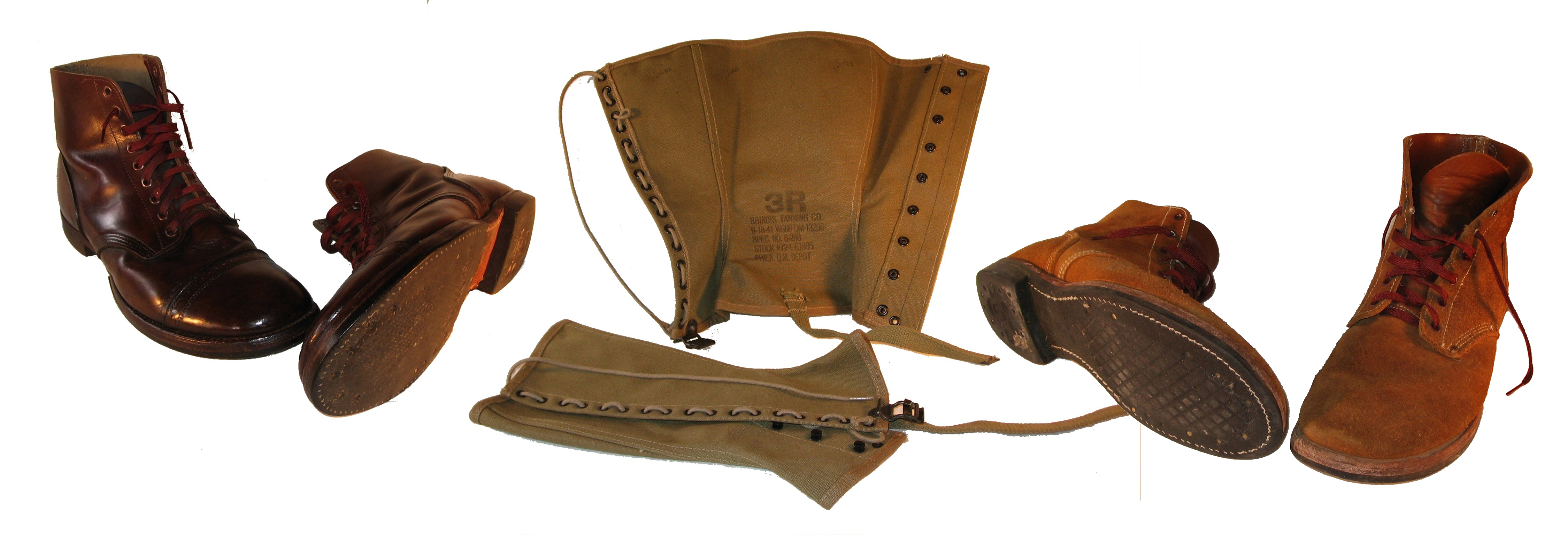M1938 LEGGINGS & SHOES, FIELD SERVICE

The M1938 legging was worn with the ankle high field service shoe to provide ankle support and keep the soldierâs trousers bloused. The legging sizes range from 1 to 5 with 1 being the smallest. The largest sizes, 4 and 5, are not common. They are all made of heavy cotton canvas. The acceptable color range for our impression is from khaki to light green with most being the later. Donât buy an OD #7 (dark green) pair.
The leggings are worn with the hooks on the outside facing toward the rear so they will not snag while walking through the brush. Lacing them is remarkably difficult for some people. You start by tying a 1/4" knot in the end of the lace. Then look at the side at the legging with the hooks and find the single eyelet at the bottom and thread the lace through it from the inside to the outside. This secures the end of the lace. Then you bridge the gap to the other side of the legging, the side with the eyelets, and thread the lace, again from the inside to the outside, through the lowest eyelet. Leave about 4" of lace in the gap between the eyelet side and hook side so you can get your booted foot through. Next, take the free end of the lace and thread it, from the outside to the inside, through the next eyelet. Now the end of the lace is on the inside so you thread it through the next eyelet from the inside to the outside. When the lace is on the outside you thread it through the next eyelet from the outside to the inside and when the lace is on the inside, you thread it through the next eyelet from the inside to the outside. Keep going until you have run the lace through all of the eyelets.
Next, make a series of loops between the eyelets on the outside of the legging. Slip your booted foot through the legging and secure the heel strap. Make sure the hooks are on the outside of your leg and facing toward the rear. Attach the first (lowest) loop to the lowest hook on the opposite side and tighten. Attach the second loop to the second hook and tighten. Adjust the heel strap if the eyelet and hook sides of the legging arenât overlapping and then continue hooking the loops to the matching eyelets, tightening as you go, until you reach the top and then secure the lace and tuck it inside your legging. To get out of the leggings you just loosen the lace at the top and unhook the loops. The process is laborious but once the lace is threaded, and with a little practice, both leggings can be put on in less than three minutes!
When you buy leggings make sure they are the M1938 pattern. This will be ink stamped on the inside with the rest on the contract information and the size. There are lots of leggings in the world to fool you. For example, USMC leggings are the right color but they don't have as many eyelets. Also, insure that you have a real pair, right and left, and not two from the same side.
The field service shoe was the predecessor and the contemporary of the "two-buckle" combat service boot. Most wartime production field service shoes were similar to the bottom portion of the combat service boot (i.e. rough side of the leather out, russet colored or brown, black rubber sole, eyelets painted brown, & plain toe) In fact, if you sew a set of buckle tops on the service shoes youâve made yourself a pair of combat service boots. Some earlier versions of the field service shoe are beautifully vegetable tanned russet leather, finished side out, with cap toes! The soles and heels can be black rubber or a composition material. The later looks like black rubber with random white threads in it.
When buying fifty year old leather boots you have to be ready to turn down more pairs than you buy. Check the leather for red-rot. If red dust comes off on your hands when you rub the leather it won't last long, maybe not even one event. Pass them up. Also check for severe dryness. If the leather cracks when you fold it on itself it is dry and weak. It can be restored to a degree with Dr. Johnsonâs Leather Restorer, or some similar lanolin containing product, but it still may not last long. Check the soles for flexibility. If the rubber feels very stiff and hard the sole will probably break when you wear it. You can only re-sole a boot if the welt is in good shape. If itâs too dry it will just tear. Keep that in mind if you are thinking of resoling. Finally, check the thread for dry rot. Stick your thumbnail in a seam and see if you can pull the seem up. If you hear threads snapping ask yourself if you are willing to hand stitch the boot back together when it comes apart; and it will come apart.
Good reproductions are available.